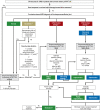The Diagnosis and Treatment of Rheumatoid and Juvenile Idiopathic Arthritis of the Temporomandibular Joint
- PMID: 34874262
- PMCID: PMC9017775
- DOI: 10.3238/arztebl.m2021.0388
The Diagnosis and Treatment of Rheumatoid and Juvenile Idiopathic Arthritis of the Temporomandibular Joint
Abstract
Background: Involvement of the temporomandibular joint can be shown in 40-90% of patients with rheumatoid arthritis and juvenile idiopathic arthritis (JIA), although it is often asymptomatic. Restricted jaw mobility and jaw pain can be found in approximately 20% of patients with JIA (prevalence: 70 per 100 000 persons). Early diagnosis and treatment of the underlying disease are essential for a good outcome, but uniform, consensus-based management is still lacking.
Methods: The clinical practice guideline is based on the findings of a systematic literature review in multiple databases and a Delphi procedure to obtain consensus on the recommendations.
Results: Most of the identified studies were retrospective. Patients with JIA should undergo clinical screening with a structured examination protocol once per year in childhood and adolescence, and thereafter as well if the temporomandibular joint is involved. The diagnosis of chronic rheumatoid arthritis of the temporomandibular joint is established with contrast-enhanced magnetic resonance imaging. Conservative treatment (antirheumatic basal therapy, local measures) is unsuccessful in less than 10% of patients. In such cases, arthroscopy and arthrocentesis can be used for temporary symptom relief and functional improvement. Intra-articular corticosteroid injections should be given only once, and only in otherwise intractable cases. In severe cases where all other options have been exhausted (<1%), open surgical treatment can be considered, including alloplastic joint replacement.
Conclusion: Oligosymptomatic and asymptomatic cases are common even with radiologic evidence of marked joint damage. The possibility of rheumatic involvement of the temporomandibular joint must be kept in mind so that serious complications can be avoided. Regular clinical evaluation of the temporomandibular joint is recommended, particularly for patients with juvenile idiopathic arthritis.
Figures



References
-
- Reich RH, Lindern JJ. Funktionelle Kiefergelenkschirurgie Mund-Kiefer-Gesichtschirurgie. In: Horch HH, editor. Urban & Fischer bei Elsevier. 4. München: 2007. pp. 189–191.
-
- Thierry S, Fautrel B, Lemelle I, Guillemin F. Prevalence and incidence of juvenile idiopathic arthritis: a systematic review. Joint Bone Spine. 2014;81:112–117. - PubMed
-
- Kienitz C, Grellmann C, Hapfelmeier J. Prävalenz der Rheumatoiden Arthritis in Deutschland: Analyse von Längsschnittdaten der Gesetzlichen Krankenversicherung. Gesundheitswesen. 2021;83:367–373. - PubMed
-
- Pantoja LLQ, de Toledo IP, Pupo YM, et al. Prevalence of degenerative joint disease of the temporomandibular joint: a systematic review. Clin Oral Investig. 2019;23:2475–2488. - PubMed
-
- Arabshahi B, Cron RQ. Temporomandibular joint arthritis in juvenile idiopathic arthritis: the forgotten joint. Curr Opin Rheumatol. 2006;18:490–495. - PubMed
Publication types
MeSH terms
LinkOut - more resources
Full Text Sources
Medical

